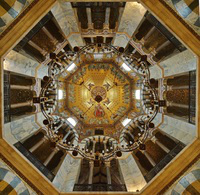Speaker
Description
The decay of the free neutron into a proton, electron and antineutrino is the simplest example of the nuclear beta decay. The lifetime of this process is measured either by beam or by storage experiments. Currently, their results show a discrepancy of about 7 s which is also known as the "neutron lifetime puzzle". Two major systematic effects in neutron experiments are losses due to up-scattering and material wall collisions. The experiment $\tau$SPECT aims to avoid these effects by using a three-dimensional magnetic storage of ultracold neutrons (UCN) produced by the recently upgraded UCN source at TRIGA Mainz [1]. Two separate methods will be used for the determination of the neutron lifetime: Detection of decay protons during storage, and counting of remaining neutrons afterwards. It is aimed for a final accuracy of 0.3 s. Earlier test measurements have successfully demonstrated the storage of UCN in the longitudinal magnetic field of $\tau$SPECT, while still using material wall storage in radial direction [2]. Phase 1 of the $\tau$SPECT experiment is currently being commissioned and enables full magnetic storage of UCN along with in-situ UCN detection. The presented poster gives an overview and discusses the current status of $\tau$SPECT.
[1] J. Kahlenberg et al., Eur. Phys. J. A 53, 226-236 (2017)
[2] J. Karch, PhD thesis, http://nbn-resolving.de/urn:nbn:de:hebis:77-diss-
1000016406 (2017)
